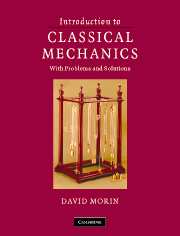Book contents
- Frontmatter
- Contents
- Preface
- 1 Strategies for solving problems
- 2 Statics
- 3 Using F = ma
- 4 Oscillations
- 5 Conservation of energy and momentum
- 6 The Lagrangian method
- 7 Central forces
- 8 Angular momentum, Part I (Constant L^)
- 9 Angular momentum, Part II (General L^)
- 10 Accelerating frames of reference
- 11 Relativity (Kinematics)
- 12 Relativity (Dynamics)
- 13 4-vectors
- 14 General Relativity
- Appendix A Useful formulas
- Appendix B Multivariable, vector calculus
- Appendix C F = ma vs. F = dp/dt
- Appendix D Existence of principal axes
- Appendix E Diagonalizing matrices
- Appendix F Qualitative relativity questions
- Appendix G Derivations of the Lv/c2 result
- Appendix H Resolutions to the twin paradox
- Appendix I Lorentz transformations
- Appendix J Physical constants and data
- References
- Index
2 - Statics
- Frontmatter
- Contents
- Preface
- 1 Strategies for solving problems
- 2 Statics
- 3 Using F = ma
- 4 Oscillations
- 5 Conservation of energy and momentum
- 6 The Lagrangian method
- 7 Central forces
- 8 Angular momentum, Part I (Constant L^)
- 9 Angular momentum, Part II (General L^)
- 10 Accelerating frames of reference
- 11 Relativity (Kinematics)
- 12 Relativity (Dynamics)
- 13 4-vectors
- 14 General Relativity
- Appendix A Useful formulas
- Appendix B Multivariable, vector calculus
- Appendix C F = ma vs. F = dp/dt
- Appendix D Existence of principal axes
- Appendix E Diagonalizing matrices
- Appendix F Qualitative relativity questions
- Appendix G Derivations of the Lv/c2 result
- Appendix H Resolutions to the twin paradox
- Appendix I Lorentz transformations
- Appendix J Physical constants and data
- References
- Index
Summary
The subject of statics often appears in later chapters in other books, after force and torque have been discussed. However, the way that force and torque are used in statics problems is fairly minimal, at least compared with what we'll be doing later in this book. Therefore, since we won't be needing much of the machinery that we'll be developing later on, I'll introduce here the bare minimum of force and torque concepts necessary for statics problems. This will open up a whole class of problems for us. But even though the underlying principles of statics are quick to state, statics problems can be unexpectedly tricky. So be sure to tackle a lot of them to make sure you understand things.
Balancing forces
A “static”. setup is one where all the objects are motionless. If an object remains motionless, then Newton's second law, F = ma (which we'll discuss in great detail in the next chapter), tells us that the total external force acting on the object must be zero. The converse is not true, of course. The total external force on an object is also zero if it moves with constant nonzero velocity. But we'll deal only with statics problems here. The whole goal in a statics problem is to find out what the various forces have to be so that there is zero net force acting on each object (and zero net torque, too, but that's the topic of Section 2.2).
- Type
- Chapter
- Information
- Introduction to Classical MechanicsWith Problems and Solutions, pp. 22 - 50Publisher: Cambridge University PressPrint publication year: 2008



